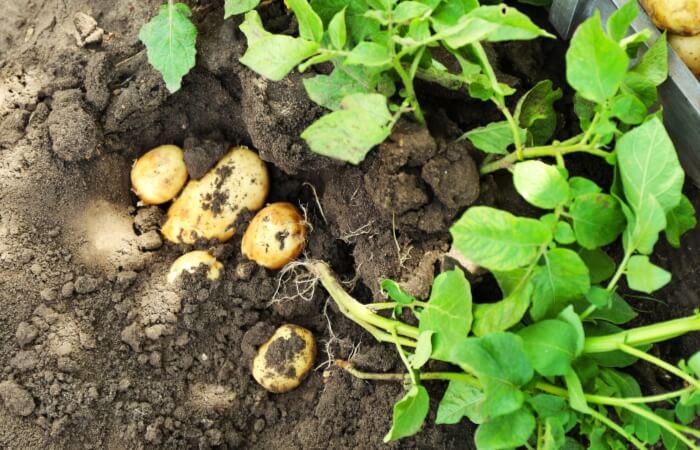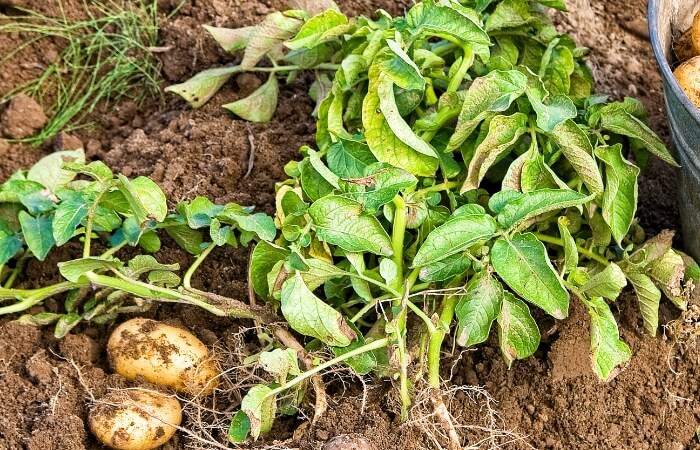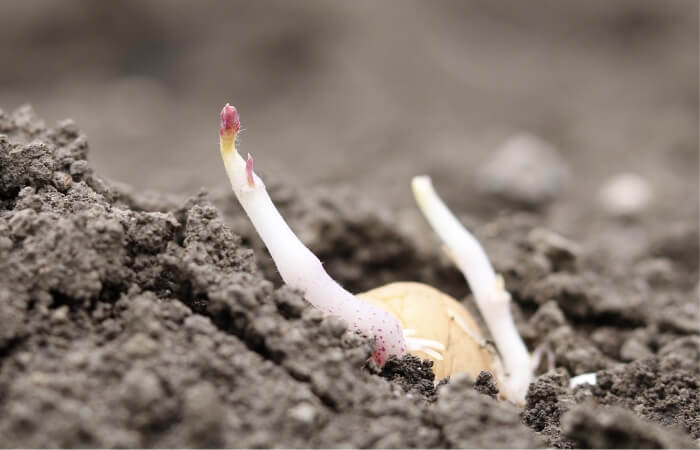When potatoes are ready to harvest, you can reap a bountiful yield of tubers to enjoy right away with your meals with plenty to store for the months ahead. But how do you know when are potatoes ready for harvest?
Things like potato variety and weather conditions play a role in when a crop reaches maturity, but there are other factors to consider.

When you know the signs your spuds are ready for harvest, growing potatoes becomes straightforward. Learn whether flowering is essential, what happens if you leave potatoes in the ground, and even if potatoes keep developing after the foliage dies.
How To Tell When Potatoes Are Ready To Harvest
Because potatoes grow in the ground, the only way to precisely monitor their growth is by digging up “test” plants, lowering final crop production if the potatoes aren’t as large as you want.
However, there are other ways to gauge when the time is right for harvesting, such as:
Look For Flowers
No matter what variety of potatoes you plant, you only need to look for the small white flowers to know there are tubers in the ground.

When potatoes flower, the size of the spuds is only an inch or two in diameter, and stores sell them as “new potatoes.”
If you enjoy the thin skin and tenderness of new potatoes, you can harvest them around the flowering stage, but they won’t store as long as a more mature potato.
Count The Days Since Planting
Depending on the potato variety, it can take anywhere from 60-120 days for the plant to reach maturity.
You can mark your calendar for the maturity date or move it forward by a few weeks to monitor your potato patch for additional signs that the spuds are ready for harvest.
Look For Soil Bulges
As the tubers grow, they displace the soil under your potato foliage, pushing the surface dirt upward and outward.
If you’re attentive to the changes on the soil surface, you’ll see the bulging and know you can start harvesting your potatoes.
Look For Wilting Foliage
The best indication it’s time to harvest mature potatoes is when the tops of the plants begin to wilt, turn brown, and fall over near the end of their growing season.

At this stage, the size of the potatoes is optimal.
How Your Climate And Potato Variety Affect When To Harvest Your Potatoes
Your Potato Variety Matters
Potato varieties will fall into three groups in relation to how many days they take to mature.
- Early-season potatoes, such as Yukon Gold, Norland, and Irish Cobbler, reach maturity within 75 to 90 days.
- Mid-season potatoes include Russet Burbank, Catalina, and Chieftain and mature in 95-110 days.
- Late-season potatoes mature in 120 to 135 days. Varieties include Kennebec, All Blue, and Butte.
Knowing the variety and considering climate conditions will help you master the optimal time to harvest a mature potato crop.
The climate in your region impacts potato development and alters your crop’s maturity date and production.
Your Climate Concerns
Potatoes are a hardy root vegetable, but they are finicky and can succumb to issues such as potato blight or Blackheart from too much rain.
Blackheart is when internal potato tissue gets black spots from lack of oxygen during development or excessive carbon dioxide after harvest.
Excessive rain that pools around your potato crop can even kill the plant or invite diseases or pests that will destroy the plants.
On the other end of the spectrum, drought conditions will greatly slow down potato development.
Tubers are about 80 percent water and need moisture to bulk up. Without enough rain or regular watering, potato tubers will be smaller than you expect at harvest time. To combat this issue, ensure your potatoes get at least one inch of water per week.
Do Potatoes Have To Flower Before Harvesting?
Flowering plays no role in tuber development.
The role of the blooms is to form fruits on foliage that looks similar to unripe tomatoes.
Potato plant flowers and fruits contain a toxic amount of solanine and should never be eaten by people or pets.
Most potato plants get blooms on some of the foliage during the growing season. The flowers appear about six to eight weeks after foliage sprouts.
Seeing potatoes flowers is an excellent sign to prep for potato harvest, but most gardening experts wait several weeks to start pulling tubers so they can plump up even more.
What Happens If You Don’t Harvest Potatoes?
Any potatoes you leave in the ground will become “seeds” for new plants.

If the weather and soil temperatures are still in a good range for growth, the potatoes will sprout and form new plants.
If the weather turns cold quickly, such as not harvesting all your potatoes before the first freeze hits, the tubers will overwinter in the ground and sprout as soon as spring weather warms the soil above 45°F.
Do Potatoes Grow After The Plant Dies?
Potato tuber development requires the plant foliage to be functioning for it to keep growing. When the plant dies, the potatoes in the ground will cease to gain any more volume.
The key to storing potatoes for a long time is to let the potatoes cure or “harden.” This process helps the skin toughen, protecting the potato’s internal tissue and providing more edible spuds for your meals.
If the weather conditions are favorable and not overly wet, you can leave the potatoes in the ground to harden naturally up to two weeks after the plant dies.
Another option is to harvest the taters, brush off the excess dirt, and lay them out on paper in a cool, dark location for about a week. After the spuds harden, you can bag or box them for long-term storage.
How Long Can Potatoes Stay in the Ground?
You can leave potatoes in the ground as long as the soil remains workable, but it does risk potential damage from pests or potato diseases.
Most gardeners who plant fall or late-season potato crops can leave the tubers in the ground until the soil begins to freeze.
However, some gardeners use mulch in thick layers over their potato rows to keep the ground from freezing during the winter and “store” their potatoes underground until they wish to consume them.
For warmer climates, or when growing early-spring potato crops, leaving potatoes in the ground for too long will cause them to sprout and form new potato plants, which you may or may not consider a good thing.
Can You Eat Potatoes Right After Harvest?
Fresh potatoes from the garden are delicious and safe to eat. The only reason you need to harden off potatoes is for long-term storage, so the thicker skins can withstand rubbing or abrasions that open up the inner flesh to pathogens.
You’ll want to wash the newly-harvested potatoes well to remove dirt and debris before cooking.
However, don’t ever wash potatoes you plan to store as the moisture will encourage diseases to grow, and the potatoes will rot.










